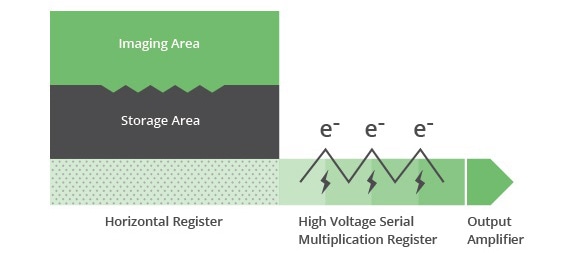Products
Your all-inclusive solution
All Products
Download our catalog
Get our Catalog
Applications
The Electron-Multiplying CCD (EMCCD) is a CCD camera to which is added a special electron multiplication output register. It is designed to practically eliminate the detrimental effect of the readout noise intrinsic to imaging devices, making them significantly more sensitive.
The readout noise generates false counts on a level comparable to a signal of a few photons. When the targeted real signal is close to or lower than this noise limit, it cannot be reliably identified by the camera. By amplifying the signal up to several thousand times with EM Gain, EMCCD cameras make the readout noise effectively negligible. EMCCDs thus can offer ultimate sensitivity for the observation of the darkest scenes, down to a signal of a single photon.
EMCCDs also support faster frame rates than their CCD counterparts, making them highly suitable for real-time imaging. Nüvü™ has completely reinvented EMCCD electronics to further reduce any other noise sources, such as thermal noise and clock-induced charges, allowing for unmatched sensitivity.
A relative of the charge-coupled device technology, the basis of the EMCCD is the photoelectric effect. Discovered by Albert Einstein, and for which he was awarded a Nobel prize, the photoelectric effect is defined by a material that generates electrons (electrical charges) following exposure to photons (light).
The EMCCD’s silicon sensor chip is designed and built to maximize the number photoelectrons generated when exposed to light, with up to 95% of photons converted to electrons. This is done by using back-thinned devices with anti-reflective coatings. The photon conversion occurs on a specific part of the sensor: the imaging region. This region is organized in rows and columns of pixels, which can be seen as points that collect the charges generated by the photoelectric effect. This matrix of pixels is what will form a recognizable image.
After the exposure, the charges in the pixels are transferred across the sensor from the imaging region to the storage region, shielded from light. This storage region is where the image is read. Using these two regions allows the EMCCD to simultaneously expose a new frame while the previous one is being read, which speeds up the acquisition. This architecture is called “frame transfer”, while cameras that expose and read sequentially are called “full frame”.
In the storage region, the charges at the detector’s bottommost row travel pixel by pixel into the multiplication register. There, the charges of each pixel are multiplied up to several thousand times. As a result, an incoming signal of even a few photons can amplified to thousands of photoelectrons. This is what is called the Electron Multiplication and what renders the readout noise negligible in EMCCDs.
Finally, photoelectrons reach the output amplifier where they are converted to a voltage and digitized to form an image. Whereas this readout must be done slowly in conventional CCDs, EMCCDs can be driven very quickly since readout noise is negligible. As such, EMCCDs benefit both from higher sensitivity and higher frame rates.
